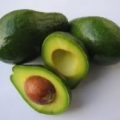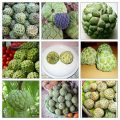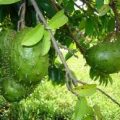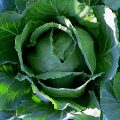The guava (Psidium guajava Linn.) is one of the distributed fruit tree crop in the tropics (like the Philippines) and subtropics and found to be indigenous to the American tropics. It has a great potential for extensive commercial production because of its ease of culture, high nutritional value and popularity of processed products. Most common areas where guavas are grown in abundance are: open areas, second-growth forests, backyard or as a part of a mixed orchard. However, at present, there are no existing records for big planting and production of guava in the Philippines.
ECONOMIC IMPORTANCE
The fruit of guava is very rich in Vitamin C, which is substantially higher than what is found in citrus. It is also a good source of Vitamin A and other important elements. The fruit contains a large amount of citric, lactic, malic, oxalic and acetic acids and trace amount of formic acid.
The ripe fruit is usually eaten as dessert. It can also be utilized in many ways for making jellies, jam, paste, juice, baby foods, puree, beverage base, syrup, wine and other processed products. It may be eaten sliced with cream and sugar and as ingredient in cakes and pies. It is also used in dishes like “sinigang”.
Some parts of guava tree have medicinal and commercial usefulness. The bark and leaves are used in childbirth to expel the placenta. The leaves can be made into tea and astringent decoction can cure stomachache and act as vermifuge. When crushed or chewed, it is used for toothache treatment; pounded leaves may also be applied locally for rheumatism; can also be used for dyeing and tanning. The bark is sometimes used in complex cosmetics for hystero-epilepsy. Its wood is moderately strong and durable indoor and useful for handle and in carpentry and turnery.
GUAVA VARIETIES/STRAINS
Supreme – The Supreme varieties from Florida. It is generally high yielding and produces a thick white flesh fruit of good quality for preserving or eating fresh. Fruit shape is ovate with distinct corrugation, 6.3 cm long, 5.5 cm in diameter and weighing 65 grams. The three is moderately prolific and regular bearing. When fully ripe, the fruit is bright yellow in color. The flavor in the inner pulp is sweet but the outer skin is slightly bitter and possesses a distinct strawberry wine odor, which is slightly astringent. It is moderately resistant to anthracnose and fruitfly but susceptible to leaf folder and aphids.
Red Indian Rolfs and Ruby – the fruit is ovate, 6.5 cm long, 5 cm in diameter with thin, smooth, medium green skin, weighing 75 grams. The fruit pulp is about 10 mm deep and red when fully ripe and has less pronounced corrugation. It is large seeded, sparsely populated but very sweet, juicy, crunchy and possesses a strong aroma. The tree is very prolific, regular bearing but easily attack by bats, moderately to anthracnose and oriental fruitfly.
Crosses between Ruby and Supreme – a large, white flesh variety from California, U.S.A.
Seedless variety – this variety has a fleshy layer, thick, that almost no seed cavity remained
Goyena Quezo de Bola (NSIC 02 Gv-01) – this is NSIC guava variety approved in 2002, being a prolific yielder possessing yellowish green color of skin, finely smooth texture with pleasant aroma and weigh 575 g/fruit.
The other outstanding varieties grown in the Philippines are Bangkok, Java, Vietnamese and Hawaiian.
SOIL AND CLIMATIC REQUIREMENT
Soil – guava does well on different soils from open sand to rather compact clay; from strongly acid (pH 4.5) to medium alkaline (pH 8.2) For good fruit production, guava should be grown in rich, deep, well drained soils high in organic matter.
Climate – a rather dry climate is favorable for guava production. It may thrive best in the tropics at elevation from sea level to 5,000 feet with a tropical or near tropical temperature requirements.
NURSERY PRACTICES
Seed germination and care of seedlings – guava seeds should be thoroughly cleaned soon after extraction from the fruits. It is necessary to treat the seeds with fungicides to prevent damping-off. They should be planted early to ensure high germination. Germinated seeds in beds or boxes with a medium of fine sand or an equal mixture of sand and topsoil. Sow them evenly in the furrows 2-3 cm apart and lightly cover with soil 0.5 – 1.0 cm deep. Water regularly to keep the soil moist.
Protect the seedlings against insect pests and diseases by spraying insecticides and/or fungicides. A month after emergence or when the first true leaves have formed transplant them in individual containers, like polybags using medium clay loam soil mixed with compost. Partial shading is necessary until the plant has recovered its growth. The plant is ready for planting or as rootstocks after one year
Propagation – guava is usually propagated by seeds. It can be propagated asexually through root suckers, root cutting, grafting, marcotting, budding, grafting and inarching.
Seed Propagation – propagation of guava is nearly always by seeds. Guavas are open-pollinated producing seedlings, which are highly variable in character. Variability in seedlings can be minimized by hand –self-pollination or individual flowers.
Root suckers and root cuttings – the use of root suckers is probably the oldest method of asexually propagating guava. Root suckers are induced by severing roots to a few feet from the base of the plants and these are transferred when roots and shoots are established.
Root cutting is done by cutting about 12-20 cm long parts of any butt very small or very large roots. These can be induced to sprout and form new plants provided it is placed in a suitable medium in a well-drained propagating bed. Both the use of root suckers and root cuttings are relatively slow methods of propagating guava.
Budding – an efficient vegetative propagation is by budding selected variety on seedling rootstock. Both the patch bud and forkert techniques are recommended onto seedling rootstock. The diameter of seedling stock and budwood should be from 15-25 mm. Budwood should be mature, bark no longer green. Condition the budwood by cutting off the leaves of selected branches 10-14 days before removing the branches for budwood. During this period the buds become more enlarged and grow more readily after budding.
Air layering – for this method, low branches of guava are bent down, about 12 – 15 cm of the branch is covered with soil and kept damp to induce root formation.
Stem cuttings – propagation by stem cuttings is made from the young wood at the end of the branches. These are rooted in sandy loam soil in propagating bed in a nursery house or shed. Guava stem cuttings treated with Indole Butyric Acid (IBA) or Napthalene Acetic Acid (NAA) proved to be successful for rooting and produce numerous and vigorous roots.
CULTURAL PRACTICES
Land Preparation – plow the area once or two times followed by several harrowings to completely pulverize and expose the soil. It is best done during the dry season.
Stake the field and dig holes at a distance of 5 – 7 meters to accommodate 277 seedlings in a hectare. In fertile soils, wider spacing is desirable.
Planting – the planting materials are transplanted into the holes earlier prepared after pruning some of the leaves and removing the plants from the containers. The plants are aligned with other trees in all directions. The best time to plant is at the onset or during the rainy season.
Weeding/cultivation – shallow cultivation around the base of the plant is recommended to prevent root injury, incorporate organic matter into the soil and to control weeds especially when trees need all the available soil moisture.
Pruning – pruning is a must in guava production. This is done if a certain form is desired like growing the tree with a spreading or symmetrical or limited crown or to keep number of branches. However, when the trees have established a strong framework and started to bear fruit, little training is required. The root sprouts; low-lying branches, disease infected and other dead branches, which are unnecessary just, have to be eliminated.
Fertilization – guava trees should be kept healthy through application of fertilizers from the time they are planted until they continue to produce fruits.
In the absence of definite information regarding the fertilizer requirements of guava in the Philippines, it is about 100-500 g ammonium sulfate will be applied around the base of each tree twice a year. The fertilizer will be applied one month after planting and 6 months after or towards the end of the rainy season. The amount will be increased, as the tree grows bigger. At the start of fruiting, each tree should be given about 300 – 500 g complete fertilizer, preferably one containing more nitrogen and potassium per application. At the peak of production (about 10 –18 years, an annual application of 2 kg or more complete fertilizer per tree, split in application may be required to sustain growth development and production of fruits.
Irrigation – no irrigation is required when trees are planted during the rainy season. But in case of prolonged dry weather, the orchard should be irrigated every 10 days or as often as maybe necessary. Irrigation when applied during fruit development can increase production through fruit size.
Intercropping – while the guava trees are not yet fully productive, intercropping of short season crops like vegetables, leguminous crops, root crops and other annual crops can be done. Aside from added income it will also prevent the growth of weeds and help cultivate the land in the orchard. However, this intercrop should be removed once the main crop becomes two crowded
CONTROL OF INSECT PESTS AND DISEASES
Insect pests:
Oriental fruit fly (Daucus dorsalis Hendel). The larvae burrow through the ripe fruits making them unfit for human consumption.
Control: Bagging the fruit. To avoid infestation, harvest fruit at the earliest possible time. Collect the infested fruits into a kerosene can with a thin layer of sand at the bottom and destroy the larva/pupa by heat
Aphids (Aphis gosypii Glover)– the pest damage the plant by feeding on young growth causing the curling of leaves.
Control: Spray with appropriate insecticide (like malathion) when necessary. Aphids are fed upon by lady beetles and by maggot of syrphid flies. They also parasitized by minute parasitic hymenopterans.
Mealy Bugs and Scale Insects:
Common White Mealy Bug (Planococcus lilacinus Ckll). It attacks and draws plant sap from the young shoots and fruits of guava. Its actual damage is economically insignificant, however, the ants that it attracts are nuisance when picking the fruits.
Control: Seldom needs remedial measures
Green Scale Insects (Coccus viridis Green). It is a soft scale that infests the young shoots, mostly on leaves. It is oval in shape, about 2 mm long, foliage green in color with an irregular V-shaped black on its back.
Control: Use of entomogenous fungi effective especially during rainy season. Use of small wash parasite, Coccophagus tibialis
Moth (Zuezera coffeae Nietn). Its pink caterpillar bores into young upright growing stems tunneling the stem center where it feeds and develops; extruding stem may suddenly die or break off at the level of the exit hole.
Control: If discovered early enough, the infested stem may be saved by inserting a coconut leaf midrib into the tunnel and pushing it in as far as it would go to speak and kill the caterpillar inside. If infested twigs has broken off spear the larva; dead infested twigs that have not broken off should be broken and the larva on pupa speared.
Diseases:
Spotting of leaves and fruits – caused by the parasitic alga, Cepaleuros mycoides Darst., is rather severe on some types and varieties in humid areas.
Control: Spraying with a Copper Fungicide
Anthracnose or Cracker – caused by Gloeasprrium psidii G. Del. The fungus produces two kinds of symptoms. Formation of cankerous spots throughout the fruit surface. These cankers are circular, dry and raised. In some areas, however, infected fruits becomes undersized misshaped, hard and dry.
Typical sunken soft lesions usually produced by anthracnose can be observed on ripe fruits. Under moist conditions, pinkish masses of spores can be seen on lesions surface. It also causes dieback of plants. On the leaves, the disease produces angular, rusty brown spots of varying sizes, usually 2-5 mm in diameter. During the rainy season, the blight of shoots is a common symptom.
Control: No control measure has ever been recommended although spray of fungicides can be recommended.
Wilting – caused by Gloremella psidii Sheld is another disease known to attack guava. The disease causes mummification and blackening of immature fruits.
PROCESSING AND UTILIZATION
Preparation of Guava Products
Guava Wine
Select ripe and sound fruits. Cut into quarters. To 1 part fruits, add 2 parts water. Boil until the fruits are soft. Strain and measure the extract. To every three (3) parts extract, add 1 part sugar. Stir and measure the extract. Cool. To every 15 to 15 liters, add one-tablespoon yeast. Place in demijohns to ferment. This will take from two weeks or longer. When the fermentation is completed, transfer into wine barrels and age for at least one year.
Guava Jelly
Select equal mixture of green and ripe guavas. Wash and cut into halves or quarters. For every kilo of guavas, add 2 liters of water. Boil in enamel or stainless steel basin for 30 minutes. Strain thru a cheesecloth bag. Crush the pulp and boil again, using 1-½ liters of water. Strain and combine the 2 extracts. Measure. To every cup of the extract, add ¾ cup of sugar and 1 tablespoon of calamansi juice. Boil once to dissolve sugar and strain. Cook over strong fire until the temperature reaches 107o-108o until a soft ball is formed when the jelly is dropped in a cup of water. Pour in sterilized dry glass jars.
REFERENCES
BROWN, E.H. Useful Plants of the Philippines. Volume 3. pp. 152-155
CORONEL, R. E. 1983. Promising Fruits of the Philippines. College of Agriculture. U.P. Los Baños. Pp. 204-231
RANTUGAN, H. 1986. Guava In: Plant Industry Guide, Bureau of Plant Industry. 13 p.
SUDIARTO and MIEN A. RIFAI. 1992 In: PROSEA Edible Fruits and Nuts. E., Verheigand and R. Colonel (Editors). Bogor, Indonesia. Pp 266-272
CENDANA, S., M. GABRIEL and E. MAGALLONA. 1984. Insect Pests of Fruits Plants in the Philippines, UPLB, College, Laguna 86 p.
Source: bpi.da.gov.ph







